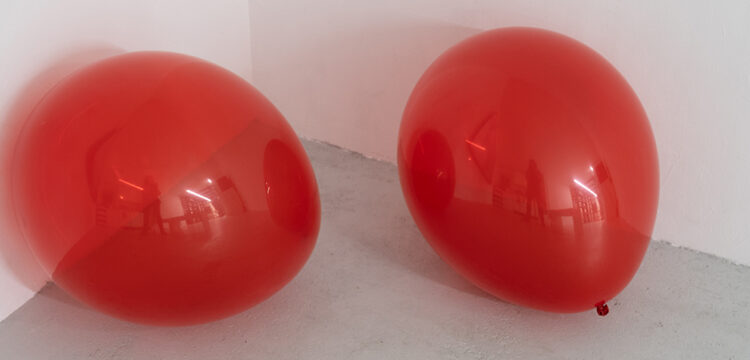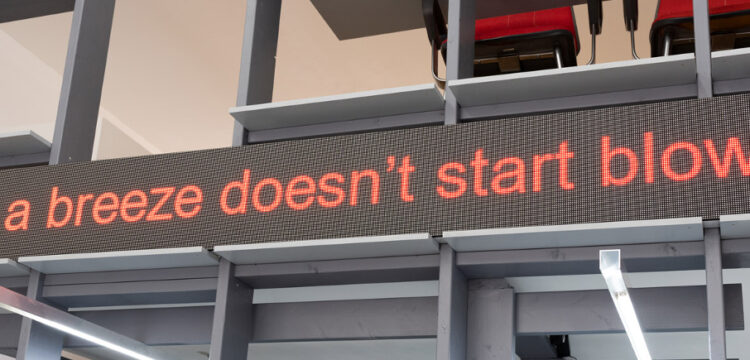The Deadly Life of an Exhibition
The Last Terminal: Reflections on the Coming Apocalypse (Part 6—The Siphon) at Rib, Rotterdam
Pauline Hatzigeorgiou reacts to the exhibition The Last Terminal: Reflections on the Coming Apocalypse (Part 6—The Siphon) at Rib, Rotterdam. This is the 6th chapter of a collective review of an exhibition that continues to change, as in their program, Rib gradually adds new works and replaces some of the existing ones, building a narrative that evolves whilst rethinking their pathways and future. This was translated from French by Jack Cox.
All of a sudden, the power’s out. The lights, the videos, the text scrolling over the LED screen facing the street through the window all turn off. But the effect of the exhibition persists or is even emphasized. The blackout, bringing all these components of digital culture to a standstill, breaking the interfaces, is a reminder of their fundamental flaw. It was all basically an illusion. For some time now, this connective network—whose inexorable expansion we watch every day as less and less is allowed to subsist outside of it—has nothing more to promise us, has no further purpose than the optimization of its own productivity. And here we find ourselves asking again if and how artistic production might possibly constitute a non-integrated underworld.
The cause of the blackout was an intervention by Mathew Kneebone, whose Power Relations synchronizes the fuse box at Rib with the live state of a network in California—epicentre of the most powerful, most profitable, and most rapidly obsolete mechanisms of control. I visited the exhibition in March. The weather in California at that time was fine, there were no forest fires (yet), no telegraph pole had just come down. And yet the network over there got saturated (definitely not for everyone).
The light in the space dimmed and the angle of our eyesight expanded through a mechanics of microgravitational falls and colliding geographies. The semantics of absence connecting the different components in the space–death, gaps, traces, language itself—intensifed the effects of presence, though for sure it was a worn-out one. From every corner of the room, an aesthetics of disappearance was transfused: nothing ever seems so close as when it’s beyond our grasp.
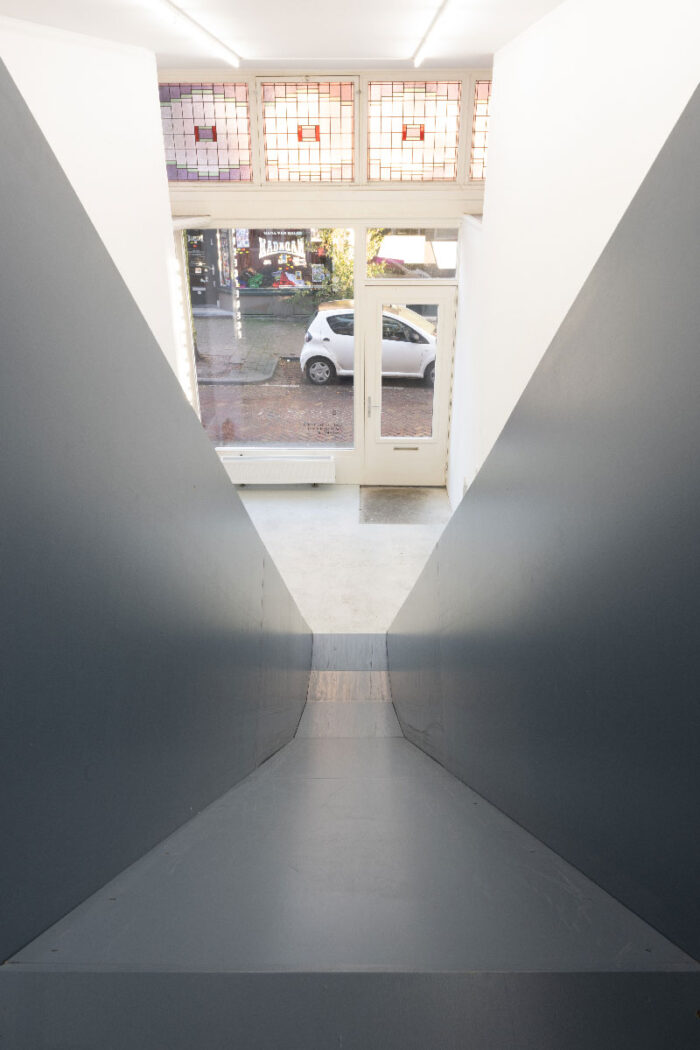
The Last Terminal—Reflections on the Coming Apocalypse has entered its sixth phase, the last in a first chapter that will have lasted almost two years. But there is nothing more conclusive here than in any of the earlier moments. Since the curator, Maziar Afrassiabi, began with the end, each of the exhibition’s installments has been a sort of update, a reset haunted by sedimented residues, by an end that never seems to come since it turns out that it’s everywhere already. You only have to think of capitalism and the globalized artworld, those persistent, moribund presences, like two interlaced corpses still funneling their assets into underground cable networks and fiberoptics.
In the meantime, it might be that this is the last exhibition Rib puts on. It’s not unlikely that the public funds that are the space’s only source of revenue will be siphoned off before the next annual budget. It’s this affective climate of neoliberal “soft paralysis“, that forces conformity on the arts sector while bankrupting it, in which the project has been carrying out its tactical bypasses while archiving itself. Artworks, reproductions, explanations, commentaries, lots of commentaries have been moving, circulating, converting within the immanence of their ebbs and flows. Artists remain, leave, reappear. Not without a certain recalcitrance however. In the space, you get the impression that some things stick, some have left, that others have been called to order, so that the version you’re visiting seems to be competing with its previous formulations as well as those to come. This is because the life of the exhibition is elsewhere, its posthumous trajectory has already begun. Everything is transformed, particularly here in the antechambers of historiography that have become the relocated spaces of the net and elsewhere, where labor and value keep on being produced.
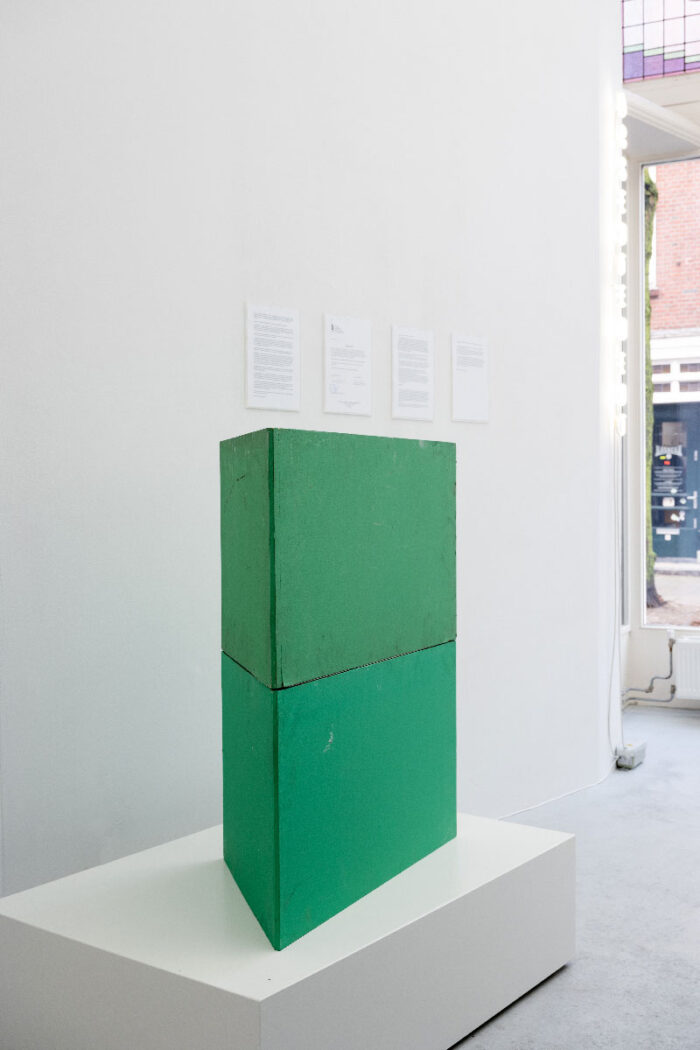
In this reconverted commercial space, which even now as a white cube keeps the proportions and the streetside accessibility of a local shop, a green plinth stands on a white plinth: two slightly battered plinths stacked on top of one another, showing the exhibition display as an artefact of its own historicity. These plinths with their triangular base come from the Museum of African Art in Belgrade. In the 1970s, they were an indiscriminate part of the building’s decor. Reading between the lines of the documents that have been exhibited with them, the plinth emerges as a subtext to the protocol that Steve Van den Bosch gave to the curator, which involved commissioning a series of descriptions of a future piece. Maziar Afrassiabi accordingly produced willy-nilly a number of mostly digressive texts, in return for which he received from the Museum of African Art Belgrade the gift of the two plinths. It makes me think of Adrian Piper’s words: “Words without artworks are empty, artworks without words are dumb,” since this case of delegated or shared authorship speaks rather well to the curatorial procedure as such, the reflexive vision that the curator attempts to provide and the frictions that appear as a result. The exhibition seems to have gone all the way in staging its own logistical conditions, from properly concrete considerations to social conditions of visibility and legitimation. This happens in particular through the division of labor that takes place here, whether in the creative rivalry between artist and curator that has existed since the sector was professionalized decades ago, or more generally in respect to the state of dispossession that artists are often confronted with in the artworld. The stakes of this can be seen in the place given to and the use made of language and paratexts in the exhibition, which display a consciousness about the pitfalls of instituting languages, like the acculturating effect that takes hold between the artwork and its description, the curator’s desire being to cut the matter short, evacuating all the excess signifieds.
An instance of this can be seen in the light work of Marije de Wit, which was exhibited at the back of the room during the earlier phases of the exhibition. The piece consisted of the words This Means That Much spelled out in lightbulbs. Without wanting to reduce it to this, the piece also addressed the imperative to mediate, the institutional injunction to set or to stabilize the work’s meaning just as the artist is called upon to categorize themselves, while remaining flexible enough to stay solvent in the prevailing artistic current. All this has an end point in the current mainstream climax in which the pertinence of an expression is directly correlated to the receptive amplitude of the markets.
This time, on the back wall, I was able to see Joseph Dabernig’s powerful video work Heavy Metal Detox, in which the artist, with his gaping mouth held up to the camera lens, prods at his gums and uses dental instruments to replace his fillings. The clinical, metallic atmosphere puts the viewer’s own teeth on edge. The visual codes remind us of a recent past—cinematic, familiar, repressed.
Before becoming an exhibition space, this place housed a butcher shop.
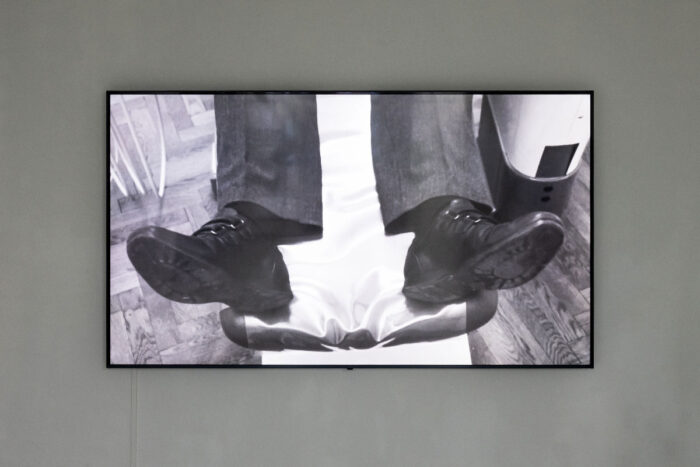
Maziar says it was a film that takes place in Iran, the birthplace he left when he was still a child, that gave him the starting point for his project. The film, which he dug out of UbuWeb, is called Le vent des amoureux [The Lovers’ Wind] or Baadeh Sabah (1970-1979) and was made by the French filmmaker Albert Lamorisse on commission from the Shah. The main interest here is the production context, the dramatic nature of which is far more impressive than the cinematic quality of the film itself. The Shah liked to sponsor celebrated Western artists, recruiting them for propaganda that he wanted to be glamourous and forward-looking. Lamorisse had become famous for a system he had developed for filming from a helicopter. The film is for the most part made up of aerial shots showing the territory of Iran, its landscapes, its inhabitants, and its funerary customs. But the Shah was dissatisfied with the first version of the film. For him, Lamorisse had failed to produce a sufficiently Westernized portrait of the country; the image was too ‘archaic’. He demanded new footage, including of the Amir Kabir dam. Lamorisse refused at first but after a series of negotiations (a risk factor had been added to the cost of compromise), he set off with a replacement film crew. The outcome feels almost inevitable: the helicopter blades got caught in the cables above the dam and the helicopter crashed into the lake, killing Lamorisse and the pilot. Le Vent des Amoureux consists of the version from 1970 followed by a brief, posthumous postscript making use of shots from the second shoot together with instructions for finishing the film that the director left behind with his family, as if he had anticipated the outcome. The film came out in 1979, shortly before the Shah’s death in exile. It enjoyed (brief) success in cinemas and was nominated for an Oscar. The two deaths are now intertwined. The protagonists’ shared ambition, their mutual thirst for power, are no longer visible in posterity. The dictator’s gaze and its obsession with the camera are gone. All that remains is the gaze of the artist as romantic hero, who seems to have crossed over to the right side of history.
The artist Kianoosh Motallebi has made a new version of the film for the sixth phase of the exhibition. The video, entitled Atal-Matal, or how the younglings, goes straight to the point, tattooing the film with a digital image of a penis in orbit, becoming erect then flaccid in a continuous loop. It’s a simple transposition of the monotonous drive to expand. But apart from its jokiness, it is also about how time, like the wind, can turn old smears into new meanings, about the continuous desire for symbolic contamination that the artist directs at the master, and vice versa. It raises questions too about the stakes of this never-ending exhibition format. We all know that the exhibition’s institutional antecedents—the museum and its rituals of burial, domestication, and reification—still contaminate these later formats, however choreographic, active, or full of life they may be.
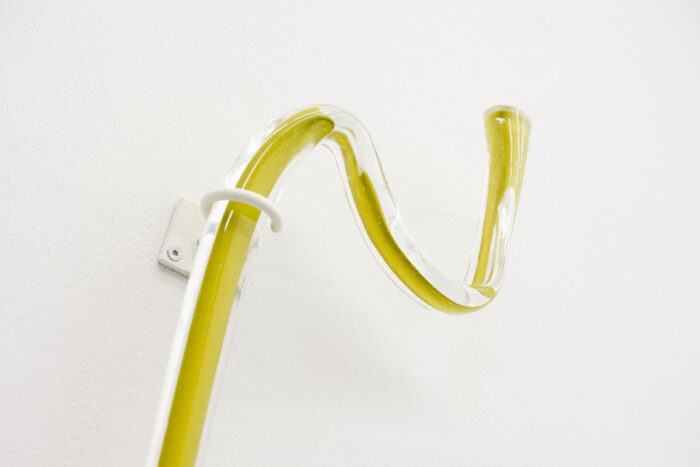
Absentement: the word spelled out vertically makes a white neon tube flicker. At first sight, Annaïk Lou Pitteloud’s piece evokes the ambivalence between the manifest effect of presence and signified distance. The piece speaks to the dislocated link between the artist and her exhibited work, caught up in the recuperative movement of capitalism from which the artist is often excluded. This word, no longer in use in modern French, describes an ‘active state of absence’. It originated in legal discourse in order to designate a default judgment, and by extension came to refer to the state of mind of someone absent from themselves or the world. This piece is the first in a series of neon signs that Pitteloud entitled Bar, both in a reference to the neon tube as well as to her idea to name a bar (‘Let’s go to L’Absentement’). Pitteloud says the series refers to the progressive disappearance of those historical working-class bastions known as the ‘brown bars’, one more manifestation of the tectonic movements taking place in reclassified urban centers. It’s something that Rib, an art space tucked into a working-class neighborhood in the south of Rotterdam, is obviously attentive to. Absentement also refers to the ongoing process of organizing accumulation and the monopoly effect that comes with it—like communicating vessels—as well as the surplus value that spurts out under all this pressure.
The white neon tube is echoed by a series of colored glass tubes in Katarina Zdjelar’s Becoming Alphabet, their sinuous curves evoking an alphabet in the making, or perhaps even one that has been forgotten. Either way, it is definitely soundless. The contorted glass describes a sort of dance of orphan signs. In another of the artist’s installations, they functioned as punctuation marks arranged in videos and archival documents that provided all the historical context of a memory of resistance, in the process asking the question of what an adequate form or aesthetic for current engagement could be. It becomes apparent that the question that is being worked through here concerns time—alienated time—caught between cyclical repetition and historical linearity. While history doesn’t exactly repeat itself, it moves by analogies. We know that change doesn’t happen immediately; it emerges from the old.
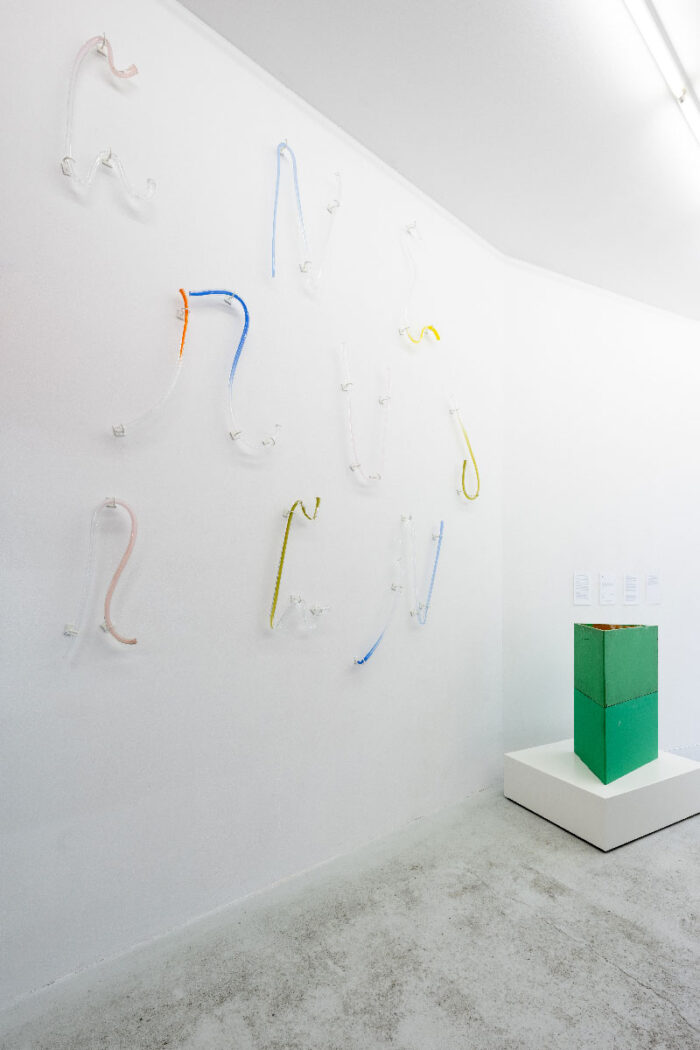
In Eléonore Pano-Zavaroni’s video, Pour Lui Y Para Todxs Lxs Otrxs, which is displayed on a shelving unit in the centre of the space, emptiness is a sign of the State’s expertly orchestrated amnesia of antifascist politics. The documentary video is without artifice and the humility of its bare presentation gives a profoundly just account of the political stakes of testimony. In it, Eléonore Pano-Zavaroni accompanies her father, Joachim Pano, to the French-Spanish border, where he is himself making a film in which he attempts to reconstruct the voyage made by his own father, an antifascist militant during the Second World War. After Franco’s victory, Joachim’s father thought he would find refuge in republican France, but like thousands of others, he was arrested by the French police and transported to various work and concentration camps, including Vernet in Arièges. Nothing remains of these sites apart from citizen archives and a few commemorative plaques half hidden under the olive trees.
In the first room, a glass display case stands apart from the wall and the object it contains—another piece by Pitteloud—is so discreet that the case also seems to be empty: a single dice, which could have been made available to the visitors to the space, who might have used it to play a game of Risk, which is also there further along on the shelf, or tested by those patient enough to find out that in fact the most frequent result is a six—apparently by a ratio of 30%. The dice is loaded, its law no longer uniform. The dots have been scraped off and the material underneath them has been meticulously hollowed out. The piece is entitled Improving the Odds: an attempt to tip the balance in social reproduction. It makes me think of where Adorno says that in aesthetic form there is, or must be, sedimented social content. This is certainly the case here, in a process that carefully eschews didacticism in the pursuit of a desire to abstract, to combine aesthetic and sociological dimensions, to register the antagonism at work in the artwork as well as in the situation of its reception. In imagining the scrupulous gestures that filed away at the mass of this little object, we have a rather clear translation from managerial technocracy to work. This piece by Pitteloud works out different ways—more or less latent, more or less marked—of disappearing, obliquely referring to the manner in which the myriad of statistical tools at the disposal of liberal governments sucks up social reality.
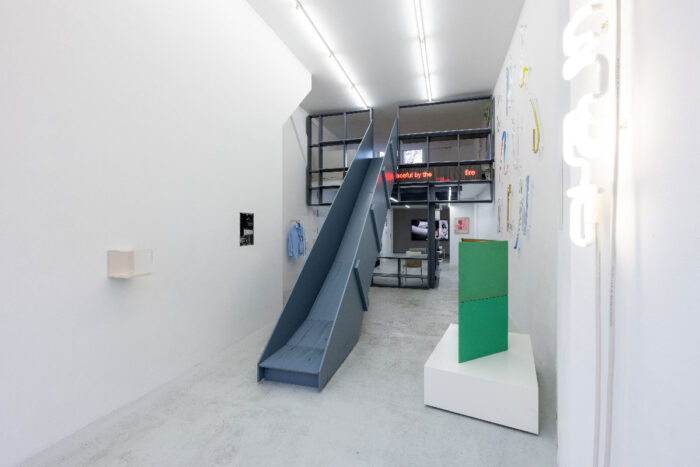
Next to this dissonant collection of absent things brought into presence, which in other contexts are called fetishes, another object draws our attention. A completely banal, light-blue shirt by the duo gerlach en koop looks like a courtroom exhibit. The breast pocket has been turned inside out, a simple gesture that transfers and accentuates the effect of a disembodied figure. Is it a figure for the contemporary symptom of the emptying out of being, of its compression? Often, when it’s not a repetition, it’s a cycle that interrupts a fiction. Is anyone there to give another throw of the dice?


